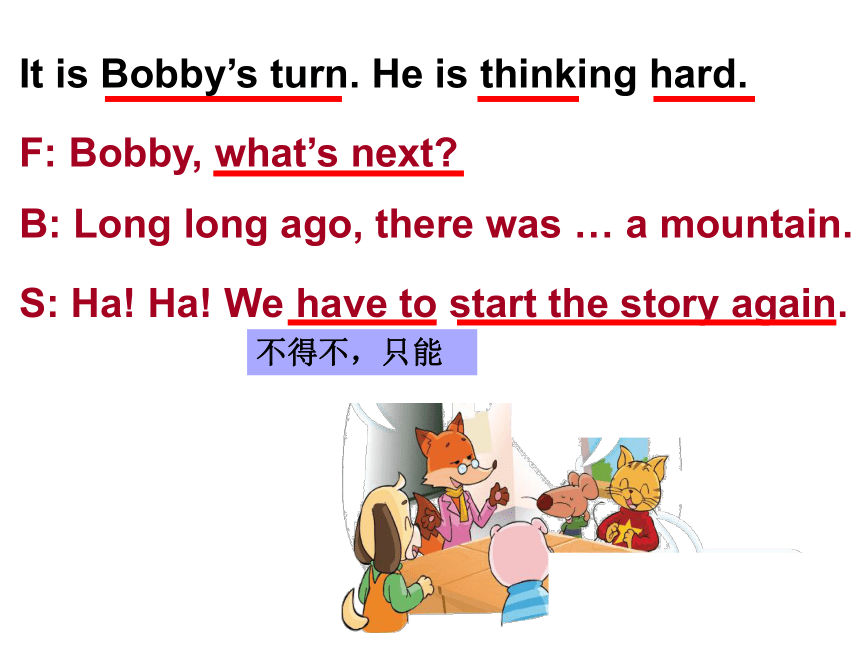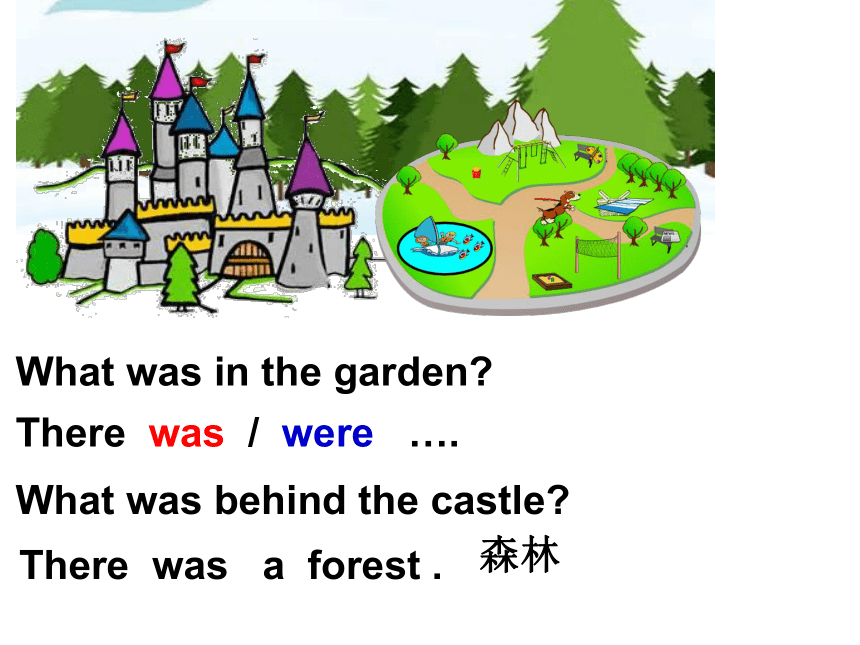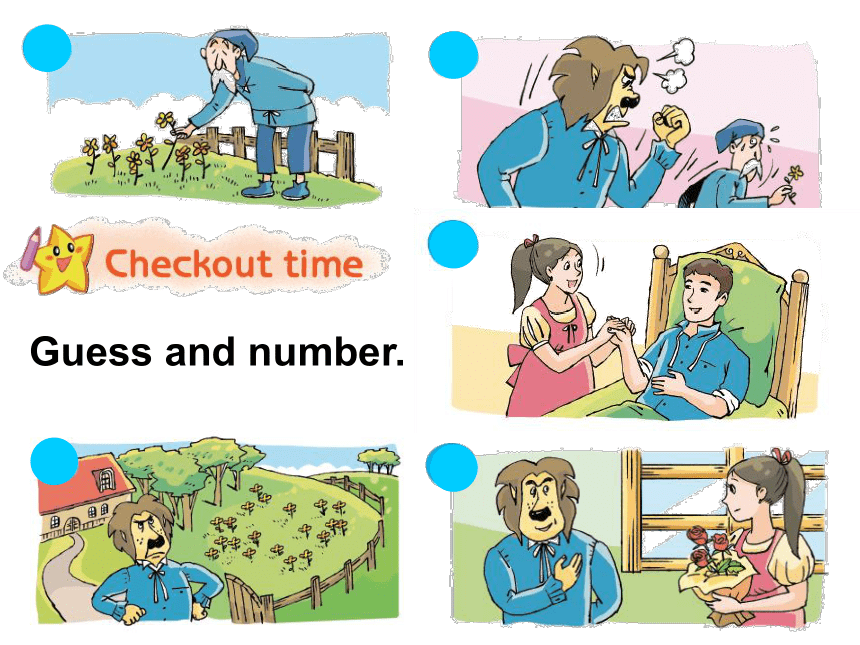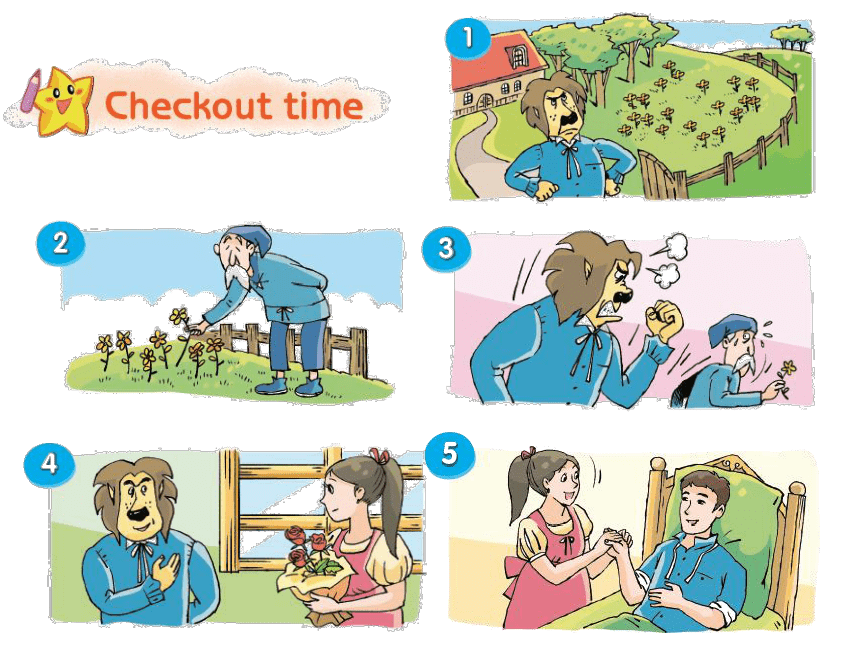Unit1 The king’s new clothes(第五课时) 课件(16张PPT)
文档属性
| 名称 | Unit1 The king’s new clothes(第五课时) 课件(16张PPT) |  | |
| 格式 | zip | ||
| 文件大小 | 1.2MB | ||
| 资源类型 | 教案 | ||
| 版本资源 | 牛津译林版 | ||
| 科目 | 英语 | ||
| 更新时间 | 2019-12-22 17:40:20 | ||
图片预览







文档简介
课件16张PPT。Willy says the next sentence. W: An old man and a little boy lived in the house. F: Wonderful, Willy!Billy says a sentence, too. B: The old man told the boy a story. F: Good! tellIt is Bobby’s turn. He is thinking hard. F: Bobby, what’s next?B: Long long ago, there was … a mountain. S: Ha! Ha! We have to start the story again.不得不,只能 Checkout time
( 5th period )What was in the garden?There was / were …. What was behind the castle? There was a forest . 森林Who lived in the forest?
What’s near his house?
What’s in the garden? Guess and number.Long long ago, there a lion. He
in the forest. There some
flowers in front of the lion’s house. was lived wereOne day, an old man by the house. He a flower. walked pickedThe lion was angry. He at the
old man, “You picked a flower. Now
me your child.” shouted giveThe old man’s child was a beautiful girl. She with the lion. The lion was nice to her. livedOne day, the lion sick. The girl looked after him. Then the lion turned into a prince. was 总结。
1)一般过去时表示过去某个时间发生的动作或存在的状态,常和表示过去的时间状语连用。一般过去时也表示过去经常或反复发生的动作。引导学生找出句子中的时间标志语,并板书。 long longago, one day。补充:yesterday, last night, three days ago。
2)Be动词在一般过去时中的变化:am 和is在一般过去时中变为was。⑵are在一般过去时中变为were。
3)动词过去式变化规则
1.一般在动词末尾加-ed,如:point-pointed, shout-shouted
2.以不发音的e结尾加-d,如:like-liked live-lived
a4) 过去式“-ed”的发音规则
(1)动词词尾为“t,d”时,发/ id /音,
want →wanted (要)need →needed (需要)
(2)动词词尾为清辅音时,发/ t / 音。
help →helped (帮助)laugh →laughed (笑)look →looked (看)
kiss →kissed (吻)wash →washed (洗)watch →watched (注视)
(3)动词词尾为t,d以外之浊辅音或元音时,发/ d /音。
call →called (叫)stay→stayed(停留)cry→cried(哭)
8. 练一练。呈现紫色部分的动词及其过去式。让学生在组内读一读并互相纠正发音。
9.. Practice. 通过写出单词过去式和用动词的适当形式填空的练习复习巩固所学一般过去时。
Let’s make our own story. 1. 很久以前,有一个国王。2. 在他的房间里有很多新衣服。3. 一天,有两个人来拜访他。4. 他们给国王看了一些神奇的衣服。5. 国王穿着他的新衣服穿过了城市。6. 人们大喊:“多美丽的衣服啊!”7. 一个小男孩指着国王大笑道:“国王什么衣服都没穿!”
( 5th period )What was in the garden?There was / were …. What was behind the castle? There was a forest . 森林Who lived in the forest?
What’s near his house?
What’s in the garden? Guess and number.Long long ago, there a lion. He
in the forest. There some
flowers in front of the lion’s house. was lived wereOne day, an old man by the house. He a flower. walked pickedThe lion was angry. He at the
old man, “You picked a flower. Now
me your child.” shouted giveThe old man’s child was a beautiful girl. She with the lion. The lion was nice to her. livedOne day, the lion sick. The girl looked after him. Then the lion turned into a prince. was 总结。
1)一般过去时表示过去某个时间发生的动作或存在的状态,常和表示过去的时间状语连用。一般过去时也表示过去经常或反复发生的动作。引导学生找出句子中的时间标志语,并板书。 long longago, one day。补充:yesterday, last night, three days ago。
2)Be动词在一般过去时中的变化:am 和is在一般过去时中变为was。⑵are在一般过去时中变为were。
3)动词过去式变化规则
1.一般在动词末尾加-ed,如:point-pointed, shout-shouted
2.以不发音的e结尾加-d,如:like-liked live-lived
a4) 过去式“-ed”的发音规则
(1)动词词尾为“t,d”时,发/ id /音,
want →wanted (要)need →needed (需要)
(2)动词词尾为清辅音时,发/ t / 音。
help →helped (帮助)laugh →laughed (笑)look →looked (看)
kiss →kissed (吻)wash →washed (洗)watch →watched (注视)
(3)动词词尾为t,d以外之浊辅音或元音时,发/ d /音。
call →called (叫)stay→stayed(停留)cry→cried(哭)
8. 练一练。呈现紫色部分的动词及其过去式。让学生在组内读一读并互相纠正发音。
9.. Practice. 通过写出单词过去式和用动词的适当形式填空的练习复习巩固所学一般过去时。
Let’s make our own story. 1. 很久以前,有一个国王。2. 在他的房间里有很多新衣服。3. 一天,有两个人来拜访他。4. 他们给国王看了一些神奇的衣服。5. 国王穿着他的新衣服穿过了城市。6. 人们大喊:“多美丽的衣服啊!”7. 一个小男孩指着国王大笑道:“国王什么衣服都没穿!”
